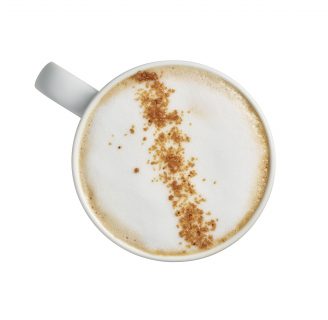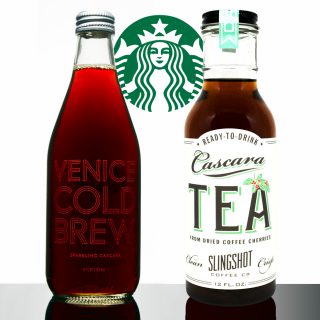Cascara. You probably don’t know what it is, but Starbucks is betting you’re going to want some.
During its annual meeting in New York earlier this month, the coffee giant announced its intention to accelerate the roll-out of its Starbucks Roastery Reserve concept stores, the first of which launched in Seattle in 2014. Beyond bringing coffee roasting, brewing and mixology all together under the same roof under the banner of premiumization, the large-scale locations are also supposed to be incubators for drinks that can later be integrated into the menu at all Starbucks retail stores.
The first such drink to make the jump, the Smoked Butterscotch Latte, debuted for a limited time earlier this year. And while smoked butterscotch may not be everyone’s ideal complement to espresso and steamed milk, most will at very least understand what the ingredients are. That may not be the case with Starbucks’ second Roastery-inspired offering, set for a limited run nationwide starting next month: the cascara latte.
Okay, that’s the second time we’ve said it, so let’s explain it: though it’s been brewed by coffee specialists for years, cascara is still relatively unknown by the mass public. Cascara, or “husk” in Spanish, is the dried skin of the coffee cherry, or the fruit from the coffee plant. During cultivation, growers keep the pulped skins after the beans have been removed from the cherry and let them dry in the sun. The resulting product is then typically prepared as an infusion, which has a flavor profile that balances sweet and tart and less caffeine than coffee.
“We asked baristas from the Roastery to create a beverage incorporating the subtly sweet flavor of cascara and as a result, their handcrafted creations inspired Starbucks to share Cascara with customers nationwide for a limited time in January,” wrote Maggie Jantzen, manager for global communications at Starbucks, in an e-mail to BevNET.

Cascara has been a staple of East African cafe culture for centuries. In Yemen and Ethiopia, it is typically finely ground and steeped with spices like nutmeg and cinnamon to make a drink called “Hashara” or “Qishr.”
Though Starbucks represents the largest food service platform for cascara, other coffee shops have already been making their own versions of the drink. Oakland-based Blue Bottle Coffee serves a cascara fizz in its cafes in New York and California, while Blue State Coffee of New England offers three varieties: hot, cold and carbonated. Its use isn’t limited to non-alcoholic beverages, either: New Belgium Brewing Company released a limited edition dark ale made with dates and cascara called “Cascara Quad” in 2012.
Still, there haven’t been many RTD releases — yet. So if cascara’s debut on the Starbucks menu is, by far, the biggest indication thus far of cascara’s potential as a beverage enjoyed by consumers all over the world, it’s also a welcome sign for brands already producing their own versions.
Venice Cold Brew, a finalist in the New Beverage Showdown at BevNET Live Winter 2016 in December, recently launched a bottled cascara that is made with pure spring water, cold brewed for 14 hours and lightly carbonated. In an interview with BevNET, the brand’s founder, Chris Mueller, echoed the belief that Starbucks could help propel cascara to mainstream acceptance.
“Our distributors all sort of kicked up a notch when they heard that Starbucks will be launching a cascara latte,” Mueller said. “Everyone’s in from that informational standpoint. [Starbucks] is an information channel; it helps so many people to just ask the needed questions. I think the beauty for us is that is exactly what we are doing at Venice.”
Venice’s fizzy take on cascara is indicative of the myriad of ways in which the source ingredient can be presented. Mueller’s approach, inspired by the brand’s roots in southern California, in adding carbonation was to emphasize the “beautiful, popping tropical fruit flavors” within cascara, including sour cherry, tamarind and jicama.
“In the same way that beans from different regions have a different taste, you are going to have different swings within cascara,” Mueller said. He described Venice’s version as having a similar caffeine content to black tea and containing 20 percent of the daily recommended allowance for potassium. But it’s the rich and complex flavor profile that emerges from slow extraction — rather than blending a pre-made syrup with hot espresso and steamed milk — that Mueller believes will give his product a distinct advantage over Starbucks’ offering.
“For us, cold brewing over 14 hours allows us to pull all the complexity out of that fruit,” Mueller added. “We are pulling everything from that fruit and we are giving it to you. It’s that complexity that merits the quality and the cost that you would go for when you buy a bottle of our product.”
Jenny Bonchak, co-founder of Slingshot, another entrepreneurial beverage company, was one one of the earliest domestic producers of ready-to-drink cascara tea. The company makes a 12 oz. version in a glass bottle that is sold mainly through the natural grocery channel at retailers like Whole Foods, Earth Fare and Trader Joe’s. Slingshot’s approach to the ingredient aligns with Bonchak’s preference for a clean, balanced profile that captures the natural flavor of the coffee cherry.
“For us, what is a differentiating factor is the cherries we are able to source are single origin and single variety,” Bonchak said. She described the flavor of Slingshot cascara tea as “tart like white grape and sweet like fig.”
“We can pinpoint exactly where those cherries came from and that allows us through our brewing method to bring out that flavor that is naturally there,” she added.
Aside from the end product, cascara also presents an intriguing sustainability play — at a time when such initiatives, like using “ugly” produce and reducing waste products is in vogue — maximizing output from farmers’ coffee harvests and providing them with a secondary revenue stream that requires minimal additional labor.
“It was a way to pay homage of sorts to the coffee farmer,” Bonchak said of her initial inspiration for brewing cascara. “We are very lucky to have a fantastic relationship with a world-renowned coffee farmer in El Salvador where we source our coffee cherries. It was a way for us to see an opportunity for him to be able to utilize more of what he is working so hard to do. By doing that, we see opportunity for us to then embrace things that we love about the coffee industry.”
Mueller even sees potential to establish a handful of farms in El Salvador that could provide a consistent supply of dried cascara husks.
Regardless of cascara’s long-term prospects, both Mueller and Bonchak agree that Starbucks’ adoption of the ingredient bodes well for all brewers utilizing the dried coffee fruit.
“When we see Starbucks joining us in something we’ve been doing for years already, that’s great,” Bonchak said. “It signals to us that our interest and passion in cascara was something noteworthy and interesting to other people, including Starbucks. It they want to tell millions of people who go there what cascara is, that’s only going to support the interest in cascara in the long run.”
“For us to be on market now with a sparkling bottled product before an announcement like [Starbucks’] is made, that feels pretty exciting,” Mueller said. “That feels like how it should be.”

